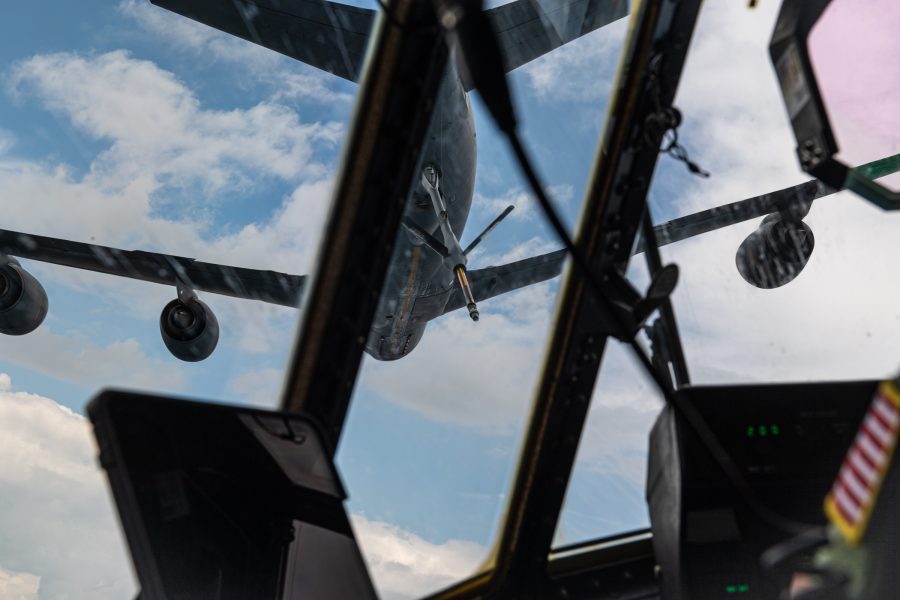While U.S. Air Force’s jets and bombers are the nation’s fight-tonight force, aerial refueling before and after those forces go into the fight is often the key to those missions.
On the 100th anniversary of the first aerial refueling mission, the Air Force sought to highlight the behind-the-scenes efforts of some of its most essential planes with Operation Centennial Contact. More than 150 tankers from 26 installations were involved in large-scale flyovers across the country.
All 50 states were originally slated to have flyovers, but weather conditions forced some units to adjust their flight paths and schedules.
Air Mobility Command’s tankers allow sorties to go on at length with limited interruption—from fighter combat air patrols and intercontinental bomber missions to keeping the E-4B “Doomsday Plane” in the skies.
“Today’s U.S. Air Force air refueling capabilities deliver unrivaled rapid global reach for U.S. forces and our Allies and partners throughout the globe,” Air Mobility Command said in a news release. “Aerial refueling serves as a force multiplier, increasing the speed, range, lethality, flexibility, and versatility of combat aircraft.”
According to the Air Force, the first aerial refueling occurred on June 27, 1923, with aviators from the Army Air Service, the Air Force’s predecessor.
“On that day, 1st Lt. Virgil Hine and 1st Lt. Frank W. Seifert, flying a DH-4B, passed gasoline through a gravity hose to another DH-4B piloted by Capt. Lowell H. Smith and 1st Lt. John P. Richter, accomplishing the first aerial refueling,” the AMC release stated.
To highlight what has turned from an experiment into something that is now a “critical capability” to the Department of Defense’s operations, Air Mobility Command had its fleet of tankers—from the 1950s-era KC-135 Stratotankers to KC-10 Extenders and the newest KC-46 Pegasus showcase their mission. The participating units were extensive, according to an AMC spokesperson:
- 97th Air Mobility Wing (Altus Air Force Base, Okla)
- 459th Air Refueling Wing (Joint Base Andrews, Md.)
- 101st Air Refueling Wing (Bangor Air National Guard Base, Maine.)
- 117th Air Refueling Wing (Sumpter Smith Joint National Guard Base, Birmingham, Ala.)
- 168th Wing (Eielson Air Force Base, Alaska)
- 92nd Air Refueling Wing (Fairchild Air Force Base, Wash.)
- 190th Air Refueling Wing (Forbes Air National Guard Base, Kan.)
- 434th Air Refueling Wing (Grissom Air Reserve Base, Ind.)
- 154th Air Refueling Wing (Joint Base Pearl Harbor-Hickam, Hawaii)
- 155th Air Refueling Wing (Lincoln Air National Guard Base, Neb.)
- 189 Air Refueling Wing (Little Rock Air Force Base, Ark.)
- 6th Air Refueling Wing (MacDill Air Force Base, Fla.)
- 452nd Air Mobility Wing (March Air Reserve Base, Calif.)
- 22nd Air Refueling Wing (McConnell Air Force Base, Kan)
- 134th Air Refueling Wing (McGhee Tyson Air National Guard Base, Tenn.)
- 305 Air Mobility Wing (Joint Base McGuire-Dix-Lakehurst, N.J.)
- 60th Air Mobility Wing (Travis Air Force Base, Texas)
- 186th Air Refueling Wing (Key Field, Miss.)
- 128 Air Refueling Wing (General Mitchell Air National Guard Base, Wis.)
- 151th Air Refueling Wing (Roland R. Wright Air National Guard Base, Utah.)
“Air refueling propels our Nation’s air power across the skies, unleashing its full potential,“ Air Mobility Command boss Gen. Mike Minihan said in a news release. “It connects our strategic vision with operational reality, ensuring we can reach any corner of the globe with unwavering speed and precision.”
The Air Force is hoping to rethink aerial refueling yet again, with a next-generation air refueling system (NGAS) and more KC-46s replacing KC-135s that entered the fleet closer to that first aerial refueling than today. While flying some of the Air Force’s aging refueling aircraft over the skies of the U.S., the AMC also wanted to show why it needs to plan for the future and recapitalize the tanker fleet to “remain relevant in the current and future security environments,” the command said.
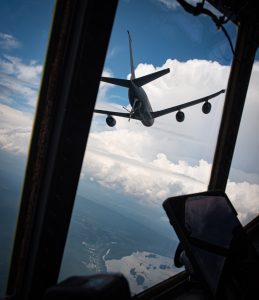
A KC-135R from the 171st Aerial Refueling Wing flies in formation with a EC130J from the 193rd Special Operations Wing in Harrisburg, Pennsylvania, June 27, 2023. U.S. Air National Guard photo by Senior Airman Diana Snyder
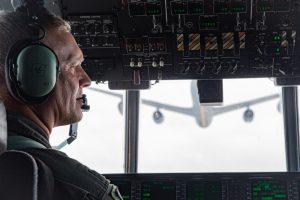
U.S. Air Force Col. Gordon Frankenfield, 193rd Special Operations Group commander, participates in a formation flight with a KC-135R Stratotanker from the 171st Aerial Refueling WIng over Harrisburg, Pennsylvania, June 27, 2023. U.S. Air National Guard photo by Senior Airman Diana Snyder
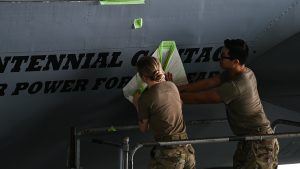
Airmen with the 6th Maintenance Squadron apply a decal on a KC-135 Stratotanker assigned to the 6th Air Refueling Wing at MacDill Air Force Base, Florida, June 22, 2023. The artwork was designed for Operation Centennial Contact, a mission celebrating how air refueling has contributed to global air power for 100 years. U.S. Air Force photo by Airman 1st Class Sterling Sutton

A pirate decal is shown on a KC-135 Stratotanker assigned to the 6th Air Refueling Wing at MacDill Air Force Base, Florida, June 22, 2023. Airmen assigned to the 6th Maintenance Squadron prepared the decal for Operation Centennial Contact, an operation celebrating how air refueling has contributed to global air power for 100 years. U.S. Air Force photo by Airman 1st Class Sterling Sutton
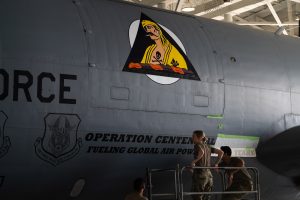
Airmen with the 6th Maintenance Squadron apply a decal on a KC-135 Stratotanker assigned to the 6th Air Refueling Wing at MacDill Air Force Base, Florida, June 22, 2023. The artwork was designed for Operation Centennial Contact, a mission celebrating how air refueling has contributed to global air power for 100 years. U.S. Air Force photo by Airman 1st Class Sterling Sutton
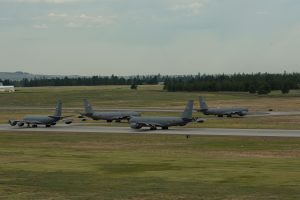
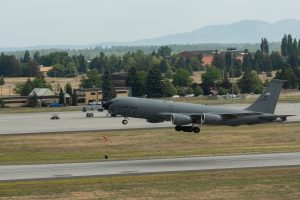
A KC-135 Stratotanker from Fairchild Air Force Base takes off from the flightline as part of Operation Centennial Contact at Fairchild Air Force Base, Washington, June 27, 2023. The movement, which included stops at Yellowstone National Park, Mount Rushmore and Glacier National Park, was part of Air Mobility Command’s celebration of 100 years air refueling operations and demonstrated the 92nd Air Refueling Wing’s global reach capabilities. Since its inception in 1923, Air refueling has become a crucial component of military and civilian aviation operations around the world by extending the range and endurance of aircraft and enabling them to complete missions that would otherwise be impossible or require multiple stops. As a result, this capability is essential for strategic and tactical operations, as well as humanitarian relief efforts in support of AMC, U.S. Transportation Command and Department of Defense priorities. U.S. Air Force photo by Airman 1st Class Clare Werner
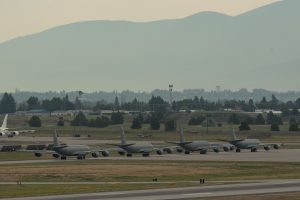
KC-135 Stratotankers assigned to the 92nd Air Refueling Wing and the 141st Air Refueling Wing taxi into position before minimum-interval takeoffs as part of Operation Centennial Contact at Fairchild Air Force Base, Washington, June 27, 2023. The movement, which included stops at Yellowstone National Park, Mount Rushmore and Glacier National Park, was part of Air Mobility Command’s celebration of 100 years air refueling operations and demonstrated the 92nd Air Refueling Wing’s global reach capabilities. Since its inception in 1923, Air refueling has become a crucial component of military and civilian aviation operations around the world by extending the range and endurance of aircraft and enabling them to complete missions that would otherwise be impossible or require multiple stops. As a result, this capability is essential for strategic and tactical operations, as well as humanitarian relief efforts in support of AMC, U.S. Transportation Command and Department of Defense priorities. U.S. Air Force photo by Airman 1st Class Clare Werner
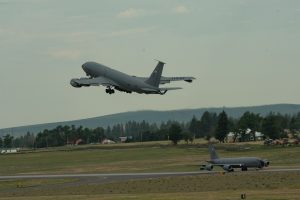
A KC-135 Stratotanker from Fairchild Air Force Base takes off from the flightline as part of Operation Centennial Contact at Fairchild Air Force Base, Washington, June 27, 2023. The movement, which included stops at Yellowstone National Park, Mount Rushmore and Glacier National Park, was part of Air Mobility Command’s celebration of 100 years air refueling operations and demonstrated the 92nd Air Refueling Wing’s global reach capabilities. Since its inception in 1923, Air refueling has become a crucial component of military and civilian aviation operations around the world by extending the range and endurance of aircraft and enabling them to complete missions that would otherwise be impossible or require multiple stops. As a result, this capability is essential for strategic and tactical operations, as well as humanitarian relief efforts in support of AMC, U.S. Transportation Command and Department of Defense priorities. U.S. Air Force photo by Airman 1st Class Clare Werner
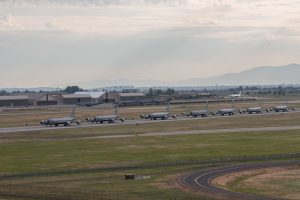
KC-135 Stratotankers assigned to the 92nd Air Refueling Wing and the 141st Air Refueling Wing taxi into position before minimum-interval takeoffs as part of Operation Centennial Contact at Fairchild Air Force Base, Washington, June 27, 2023. The movement, which included stops at Yellowstone National Park, Mount Rushmore and Glacier National Park, was part of Air Mobility Command’s celebration of 100 years air refueling operations and demonstrated the 92nd Air Refueling Wing’s global reach capabilities. Since its inception in 1923, Air refueling has become a crucial component of military and civilian aviation operations around the world by extending the range and endurance of aircraft and enabling them to complete missions that would otherwise be impossible or require multiple stops. As a result, this capability is essential for strategic and tactical operations, as well as humanitarian relief efforts in support of AMC, U.S. Transportation Command and Department of Defense priorities. U.S. Air Force photo by Airman 1st Class Clare Werner
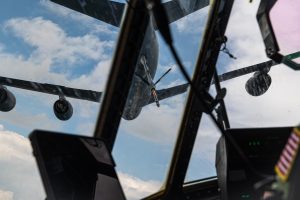
A KC-135R from the 171st Aerial Refueling Wing flies in formation with a EC130J from the 193rd Special Operations Wing in Harrisburg, Pennsylvania, June 27, 2023. U.S. Air National Guard photo by Senior Airman Diana Snyder
